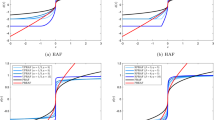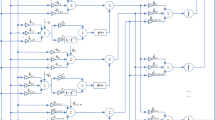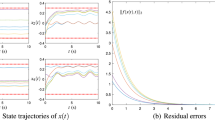Abstract
A special class of recurrent neural network termed Zhang neural network (ZNN) depicted in the implicit dynamics has recently been introduced for online solution of time-varying convex quadratic programming (QP) problems. Global exponential convergence of such a ZNN model is achieved theoretically in an error-free situation. This paper investigates the performance analysis of the perturbed ZNN model using a special type of activation functions (namely, power-sum activation functions) when solving the time-varying QP problems. Robustness analysis and simulation results demonstrate the superior characteristics of using power-sum activation functions in the context of large ZNN-implementation errors, compared with the case of using linear activation functions. Furthermore, the application to inverse kinematic control of a redundant robot arm also verifies the feasibility and effectiveness of the ZNN model for time-varying QP problems solving.














Similar content being viewed by others
Explore related subjects
Discover the latest articles and news from researchers in related subjects, suggested using machine learning.References
Boyd S, Vandenberghe L (2004) Convex optimization. Cambridge University Press, New York
Li W (1995) Error bounds for piecewise convex quadratic programs and applications. SIAM J Control Optim 33:1510–1529
Johansen TA, Fossen TI, Berge SP (2004) Constrained nonlinear control allocation with singularity avoidance using sequential quadratic programming. IEEE Trans Control Syst Technol 12:211–216
Fares B, Noll D, Apkarian P (2002) Robust control via sequential semidefinite programming. SIAM J Control Optim 40:1791–1820
Grudinin N (1998) Reactive power optimization using successive quadratic programming method. IEEE Trans Power Syst 13:1219–1225
Wang J, Zhang Y (2004) Recurrent neural networks for real-time computation of inverse kinematics of redundant manipulators. Machine intelligence quo vadis? World Scientific, Singapore
Zhang Y, Tan Z, Chen K, Yang Z, Lv X (2009) Repetitive motion of redundant robots planned by three kinds of recurrent neural networks and illustrated with a four-link planar manipulator’s straight-line example. Rob Auton Syst 57:645–651
Zhang Y, Ma W, Li X, Tan H, Chen K (2009) MATLAB Simulink modeling and simulation of LVI-based primal-dual neural network for solving linear and quadratic programs. Neurocomputing 72:1679–1687
Leithead WE, Zhang Y (2007) O(N 2)-operation approximation of covariance matrix inverse in Gaussian process regression based on quasi-Newton BFGS method. Commun Stat Simul Comput 36:367–380
Leibfritz F, Sachs EW (1999) Inexact SQP interior point methods and large scale optimal control problems. SIAM J Control Optim 38:272–293
Boggs PT, Tolle JW (1995) Sequential quadratic programming. Acta Numer 4:1–51
Murray W (1997) Sequential quadratic programming methods for large-scale problems. Comput Optim Appl 7:127–142
Hu J, Wu Z, McCann H, Davis LE, Xie C (2005) Sequential quadratic programming method for solution of electromagnetic inverse problems. IEEE Trans Antennas Propag 53:2680–2687
Chua LO, Lin G (1984) Nonlinear programming without computation. IEEE Trans Circuits Syst 31:182–188
Kennedy MP, Chua LO (1988) Neural networks for nonlinear programming. IEEE Trans Circuits Syst 35:554–562
Benson M, Carrasco RA (2001) Application of a recurrent neural network to space diversity in SDMA and CDMA mobile communication systems. Neural Comput Appl 10:136–147
Suemitsu Y, Nara S (2003) A note on time delayed effect in a recurrent neural network model. Neural Comput Appl 11:137–143
Zhang Y, Ma W, Cai B (2009) From Zhang neural network to Newton iteration for matrix inversion. IEEE Trans Circuits Syst I 56(7):1405–1415
Zhang Y, Ge SS (2005) Design and analysis of a general recurrent neural network model for time-varying matrix inversion. IEEE Trans Neural Netw 16(6):1477–1490
Zhang Y, Jiang D, Wang J (2002) A recurrent neural network for solving Sylvester equation with time-varying coefficients. IEEE Trans Neural Netw 13(5):1053–1063
Li Z, Zhang Y (2010) Improved Zhang neural network model and its solution of time-varying generalized linear matrix equations. Expert Syst Appl 37((10):7213–7218
Zhang Y, Li Z (2009) Zhang neural network for online solution of time-varying convex quadratic program subject to time-varying linear-equality constraints. Phys Lett A 373:1639–1643
Myung H, Kim J (1997) Time-varying two-phase optimization and its application to neural-network learning. IEEE Trans Neural Netw 8:1293–1300
Mead C (1989) Analog VLSI and neural systems. Addison-Wesley, Reading
Acknowledgments
This work is supported by the National Natural Science Foundation of China under Grants 61075121 and 60935001, and also by the Fundamental Research Funds for the Central Universities of China. In addition, the authors would like to thank the editors and anonymous reviewers sincerely for their constructive comments and suggestions which have really improved the presentation and quality of this paper very much.
Author information
Authors and Affiliations
Corresponding author
Rights and permissions
About this article
Cite this article
Yang, Y., Zhang, Y. Superior robustness of power-sum activation functions in Zhang neural networks for time-varying quadratic programs perturbed with large implementation errors. Neural Comput & Applic 22, 175–185 (2013). https://doi.org/10.1007/s00521-011-0692-5
Received:
Accepted:
Published:
Issue Date:
DOI: https://doi.org/10.1007/s00521-011-0692-5




